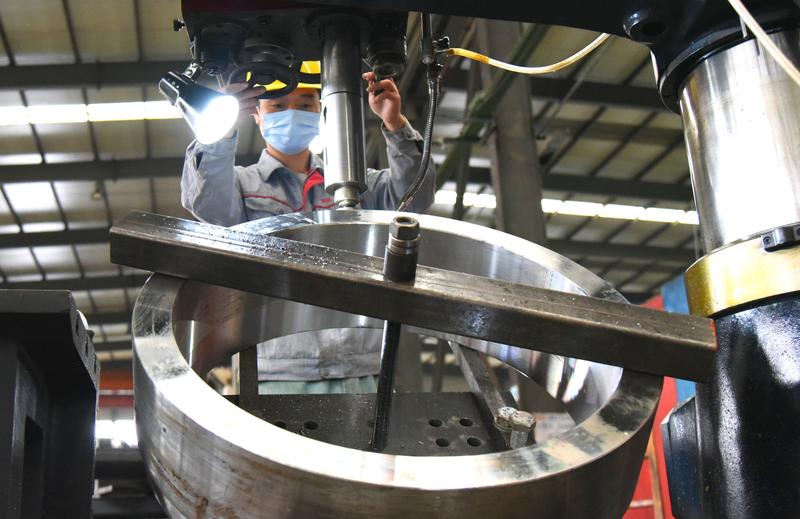High commodity prices have hit sustainability of earnings recovery
 A technician works on the production line of textile machinery components at a plant in Lianyungang, Jiangsu province. (GENG YUHE / FOR CHINA DAILY)
A technician works on the production line of textile machinery components at a plant in Lianyungang, Jiangsu province. (GENG YUHE / FOR CHINA DAILY)
More policy efforts are necessary to address the imbalance in the earnings recovery of Chinese industrial firms, as high commodity prices have further boosted upstream companies' profits but squeezed those of downstream ones, officials and experts said on Wednesday.
China's major industrial enterprises-whose core annual business revenue reaches at least 20 million yuan ($3.1 million) each-earned profits of 6.34 trillion yuan in total over the first three quarters, up 44.7 percent year-on-year, the National Bureau of Statistics said on Wednesday.
Despite the strong recovery in total profits, structural imbalances have intensified during the period, as upstream sectors such as oil, coal and metals saw their profits more than double from a year earlier. Downstream sectors like textiles and autos, meanwhile, only registered single-digit profit growth, the NBS said.
Zhu Hong, an NBS senior statistician, said industrial profits continued to grow robustly in the third quarter, but high commodity prices and supply chain woes have affected the sustainability of the earnings recovery.
"Profit imbalances between upstream and downstream sectors are fairly prominent. More efforts are needed to consolidate the foundation for earnings recovery," Zhu said.
To keep the industrial economy within a reasonable range, the country will put in place policy measures to stabilize commodity prices, expand domestic demand and promote economic upgrading, Zhu added.
Wu Chaoming, chief economist at Chasing Securities, said high factory-gate prices have underpinned the profits of upstream companies as they have also combined with lukewarm consumer demand to weigh on profits of downstream firms.
Amid the tight global supply of energy and commodities, China's producer price index, which gauges factory-gate prices, rose 10.7 percent year-on-year last month, the highest reading since the NBS started releasing the numbers in 1996.
The PPI reading may stay elevated in the fourth quarter and sustain pressure on downstream sectors, making it necessary to strengthen monetary structural support for firms facing cost pressures and alleviate their tax and fee burdens on the fiscal front, Wu said.
During the January-September period, upstream sectors of mining and raw materials took up a record-high 41.2 percent of total industrial firms' profits, while downstream manufacturers of consumer goods, excluding drugmakers, accounted for 14.8 percent, a historical low, according to Wu's estimates.
To prevent profits of downstream sectors getting squeezed due to eroding household income growth and the consumption recovery, China needs to further boost energy supplies and curb commodity price speculation, said Cai Zhibing, an associate professor of economics at the National Academy of Governance.
More importantly, longer-term reform agendas should be advanced to promote market-based pricing of electricity as well as strengthen global competitiveness of the country's industrial chains, and therefore the pricing power of exporters, Cai said.
The NBS also said high-tech manufacturing has increasingly contributed more to China's economy. Led by pharmaceutical firms and electronic equipment makers, profits of high-tech manufacturers grew 33.6 percent year-on-year in the third quarter, 19.3 percentage points higher than the industrial sector as a whole.
Zhang Yue contributed to this story.


